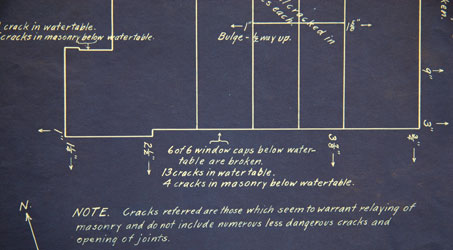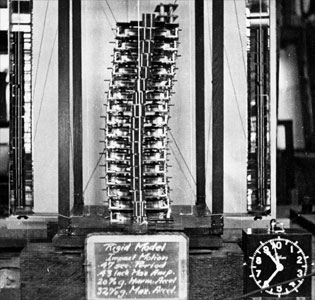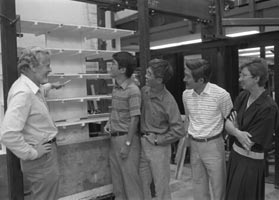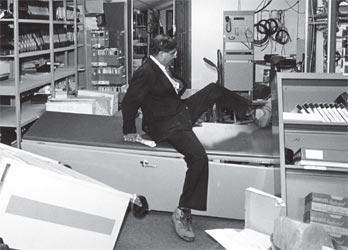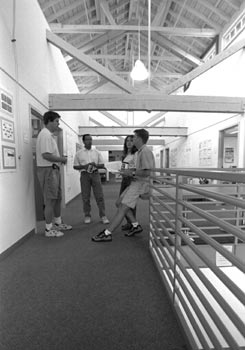|
|
||||||||||
 |
|
|
|
|||||||
|
|
||||||||||
|
|
|
|
|
|
|
|
|
|||
|
|
|
|
|
|
|
|
|
|
|
|
Walking Tour
| << Previous Stop |
 |
|||||||||
|
The destruction caused by the 1906 earthquake marked the beginning of a long and rich history of research and innovation in engineering, seismology, and geology at Stanford. The earthquake sparked interest in research and experimental work, including Professor William Rogers’ development of the first instrument to experimentally investigate soil effects during earthquakes. However, interest in earthquake risks was often short-lived and poorly-funded, so subsequent earthquakes throughout the world continued to result in great loss of life due to buildings designed with inadequate seismic resistance. Nevertheless, research at Stanford, particularly through the 1930s, laid the groundwork for modern analytical and design approaches. Significant early research was the work of Professor Bailey Willis following the 1925 Santa Barbara earthquake, the same earthquake that inspired a young John Blume to enter the field. Blume’s extraordinary career included contributions to dynamic theory, soil structure interactions, and the inelastic behavior of structures, earning him the title of the “Father of Earthquake Engineering.” In conjunction with the advent of computer modeling and measurement tools, the 1971 San Fernando and the 1972 Managua earthquakes stimulated sustained interest in earthquakes and contributed to the founding of the John A. Blume Center for Earthquake Engineering at Stanford in 1974. Engineering Faculty Inspects Buildings: Marx, Wing, and Durand
Immediately following the 1906 earthquake, President David Starr Jordan appointed Charles David Marx, a member of Stanford’s first faculty and head of the civil engineering program, to lead a team that would inspect the damaged buildings (Figure 1). Marx, who was selected for his “hands on, can do” attitude, was joined by engineering faculty members Charles B. Wing (civil) and William F. Durand (mechanical). The team was instructed to report on the present condition of the buildings, what work would be necessary to restore them to a condition of safety, and the approximate cost of such restoration. After assessing all 42 Stanford buildings and analyzing their findings, the team submitted its recommendations: “Such of the buildings as are necessary for carrying on the University work can easily be made ready for occupancy on the opening day of the University on August 23rd, 1906.” The Board of Trustees subsequently enlisted the Marx, Wing, and Durand faculty team as the Commission of Engineers that would supervise the reconstruction effort. “The outlook was not a cheerful one,” Marx said as they began the work, but the trustee’s selection of the committee was significant because it showed that the Board “believed that the men who had been called to teach others how to work were competent to do the work they professed to teach.” The Commission of Engineers faced many challenges over the next months, including a two-week labor strike, but was nonetheless successful in cleaning up the devastated campus and repairing and improving the most important buildings in time for the University’s opening in the fall. The committee continued its work with great devotion until it was disbanded in December 1908. After Loma Prieta in 1989, the engineering faculty would again come to the aid of the University to provide immediate assistance with building assessments and recommendations. Early Earthquake Experiments and Researchers: Rogers, Willis, and Jacobsen The 1906 earthquake intrigued scholars at Stanford. In that year, Assistant Professor of Physics, F. J. Rogers, used a shaking table for experiments on the dynamic response of soil to ground motion. At the request of Vice President Branner, Rogers’ report, “Experiments with a Shaking Machine,” was “undertaken with the hope of offering some explanation, based directly on experiment, of the greater destructiveness of earthquakes in regions where the foundations of structures are supported by more or less soft ground than where these foundations are based on solid rock.” The Stanford Department of Mechanical Engineering constructed the table, and 74 tests were made in all with table frequency, amplitude, and moisture content of the sand as the principal parameters. The testing found that moderately dry sand moved with the motion of the shake table at frequencies less than 2.5 cycles per second but wet sand had much more motion than the table. In concluding the report, Rogers stated, “To those interested in seismology the important question is: How do these experiments help to explain the greater destructiveness of earthquakes in regions where foundations are in alluvial soil than where foundations rest directly upon rocky strate? To pass from experiments upon a box containing half a ton of soil to the destructive effects of an earthquake is certainly a great leap. […] However, it seems to me beyond question that a soft, semi-fluid mass of soil, containing a large amount of water and surrounded or partially surrounded by soil strata, will not oscillate with the same motion as the surrounding strata. […] Finally, the greater relative motion of such a soft or semi-fluid mass is not prevented by overlaying strata of drier and more compact material.” The 1925 Santa Barbara earthquake spurred renewed interest, which was when Dr. Bailey Willis asked that a vibration laboratory be built and that a shaking table be an integral part of it. Dr. Lydik S. Jacobsen designed the table, which was constructed using gift funds. The 10x12 foot shaking table was made of 8-inch steel H-beams bolted and welded together. Weighing about 6000 pounds, it was carried on specially-ground streetcar wheels mounted on ball bearings and ran on two railroad rails. The dynamic characteristics of the table, the pendulum-table system, and the forced vibration were all developed in detail together with the complete theory. There were many possible adjustments to create a wide variety of disturbances, frequencies, and accelerations. Recording devices varied with the model being tested. In non-destructible dynamic building models with exaggerated story distortions, moving pictures were taken of the whole model which had levered dials showing the relative distortion of adjacent stories. The absolute distortion relative to “ground” was also recorded. Professor Lydik S. Jacobsen became famous for designing and building the world’s first multi-story dynamic building model for shaking table experiments, and he directed many important experiments connected with the shaking table in the following years (See Jacobsen’s Pioneering Research). Before the Blume Center was established, many additional experiments were conducted in the Stanford vibration laboratory by Harry A. Williams, Ayre, and Jacobsen.
John Blume, the “Father of Earthquake Engineering” Earthquakes played an early role in Dr. John A. Blume’s life. He grew up hearing stories from his parents who had survived the Great San Francisco Earthquake and Fire almost exactly three years before his birth. His father was a builder who had participated in the reconstruction of the city after the quake. In 1925, while driving a long-distance van for one of his many odd jobs as a young man, Blume witnessed the destruction of Santa Barbara by a 6.3 earthquake and helped with the rescue work. Thirteen people died in the quake; most of the houses survived, but a majority of the commercial buildings were severely damaged or destroyed and the Sheffield Dam collapsed, sending a river of water through part of the city. “I made a vow, then and there,” Blume said, “that someday I would do something about it.” Blume arrived at Stanford University in January of 1929 to study engineering. He created his own study plan, a mix of courses in geology, architecture and mathematics. At the time, textbooks referred to buildings as “static,” a notion Blume rejected. Receiving his A.B. degree with distinction in 1933, he then continued his studies toward a Degree of Engineer under Professor Lydik S. Jacobsen. Blume constructed the second and most exotic multi-story dynamic building model of its time in 1934. This 15-story model of a “lumped mass and spring type” could be tested over and over again without damage and its local characteristics could be altered for parameter studies. The Alexander Model is still on display in the lobby of Blume Center (Figures 2, 3). The thesis that Blume co-authored, “The Reconciliation of the Computed and Observed Periods of Vibration of a Fifteen-Story Building,” was a pioneering analysis of the dynamic response of high-rise buildings. As his later employee, Stanley Scott, explained, “Blume was convinced that in order for buildings to withstand severe earthquake loading, both elastic and inelastic ranges of motion had to be understood and considered in design. This was a revolutionary theory that Blume would continue to refine and push for inclusion in building codes and engineering design practice for the next fifty years.”
Figure 2: The Alexander Model used for testing.
Figure 3: Model testing at Stanford in the 1930s during John Blume’s time. “After thirty years as a dropout,” in which he became a world leader in earthquake engineering, started his own company and helped found the Earthquake Engineering Research Institute, Blume decided to return to Stanford in 1964, at the age of 55, to study for his Ph.D. He felt that he needed to update himself in modern areas such as matrix and computer analysis of structures, statistical methods, stochastic processes, and decision-making in civil engineering. Even though he headed a large and busy consulting firm, he pursued his studies diligently, taking course work for an entire academic year. He began work on his dissertation, “Dynamic Behavior of Multi-Story Buildings with Various Stiffness Characteristics,” under the direction of Professor Donovan H. Young. He asked for no special treatment during this time and worked in the same manner as any other student, including all-night hours at the computation center. On January 6, 1967, exactly thirty-four years to the day after receiving his A.B. degree, he was awarded the Ph.D. degree.
Dr. Blume’s dedication to education and research led him to provide fellowships that have supported many graduate students in structural engineering at Stanford. He also urged Stanford to develop an “earthquake center,” a concept that was realized in 1974. “I am very proud to have this earthquake center named after me,” he said in the EERI Oral History Series. “I like to think that their choice of name was due more to my work in the subject than to any fiscal support.” He has also endowed a chair, the John A. Blume Professorship, funded by income from two other gifts that Stanford was to pay to him for life but which he decided to give back to the University. Blume Center Technical Advancements Since its founding in 1974, the Blume Center has functioned as the umbrella for all earthquake engineering activities at Stanford. Researchers at the Blume Center have done pioneering work in many aspects of earthquake engineering, including seismic hazard and risk analysis, earthquake occurrence and ground motion modeling, component and system reliability, experimental research on structural materials, components, and models, evaluation of damage potential of ground motions, and development of seismic design methodologies (Figures 4-6).
Blume Center Seismic Strengthening after the Loma Prieta Earthquake Building 02-540 is home to the John A. Blume Earthquake Engineering Center. Built in 1912, the building was originally an industrial engineering shop and aerodynamics lab. It was constructed of lightly reinforced concrete piers and tie beams and unreinforced masonry infill with heavy wood timber trusses. Though inhabitable, the building was heavily damaged in the 1989 Loma Prieta earthquake. Since the historic building is considered to be an important part of the University heritage, every effort was made to preserve its original exterior appearance as well as all original construction material. The seismic strengthening of the Blume Center building began in 1994 and targeted four primary goals identified by the University and required by Santa Clara County: 1) improve the building to provide higher seismic strength, 2) enhance the building for disabled access, 3) update the fire suppression and detection system, and 4) upgrade the building’s telecommunications system. Similar upgrades have been completed for other historic buildings along the Panama Mall corridor. The renovation of the Blume Center building is an architectural and structural engineering success story. The building maintains its historical appeal and architectural significance while completely restoring the structural integrity to meet current code requirements for earthquake load capacity. The programmatic enhancements to the building include new testing facilities, improved teaching labs, and office space for the research students. The new advanced technology laboratory is utilized for the development of innovative structural seismic sensors, and the labs are kept constantly busy with research and testing of new ways to make buildings safer during and after catastrophic events.
|
||||||||
| << Previous Stop |
